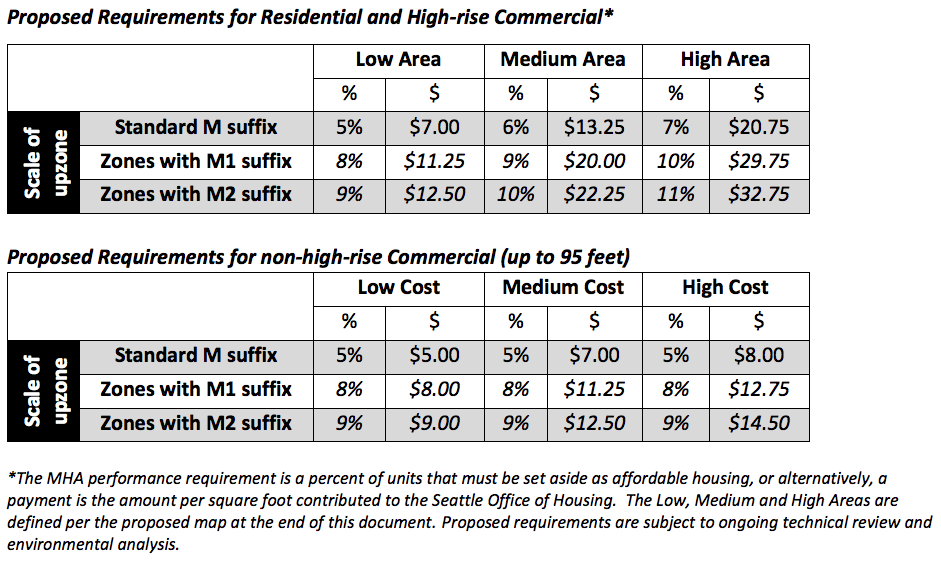
On Tuesday Sightline Institute’s Executive Director Alan Durning and Senior Researcher Dan Bertolet published a long meditation on inclusionary zoning (IZ) economics that misrepresented several key facts and relied heavily on argument by analogy rather than empirical data. The article–although focused on how inclusionary zoning is generally problematic–actually argues that Seattle’s iteration of inclusionary zoning with offsets is good and strikes the right balance. On the second part we can agree.
Or at least we did until later in the day when Bertolet maybe changed his mind. You be the judge of this comment on the popular Facebook group City Builders: “Portland has the right approach to IZ. (Not so sure about Seattle…)” It’s perhaps no surprise since Bertolet was a noted critic of inclusionary zoning before he joined Sightline (here, here, and here). And he continued to be pretty skeptical in his previous Sightline musings: “Getting [inclusionary zoning] right will be like shooting an apple off someone’s head with a shotgun: you’d better aim high. Oh, and the person with the apple is also dancing.”
What exactly was Sightline trying to accomplish with its latest harsh critique of inclusionary zoning but not necessarily Seattle’s example? Perhaps they just want to make sure cities adopt strong well-balanced inclusionary zoning policies rather than counterproductive ones, a goal we share. A more cynical take: they wanted to cover their market urbanist street cred even while still ostensibly supporting Seattle’s IZ program, which Durning helped negotiate as a member of the Housing Affordability and Livability Agenda (HALA) committee. Perhaps they’re just trying to keep the affordability requirement as low as possible.
Why does it matter? Seattle leads the nation in tower cranes–a lot of housing construction is happening–but Seattle also apparently leads the nation in rent increases. Even with all the construction, Seattle has a housing shortage, albeit the scale of the housing shortage is sometimes exaggerated. In such an environment, we must help residents weather skyrocketing rents. Seattle is still in the process of enacting inclusionary zoning or “Mandatory Housing Affordability” (MHA) as the City has branded it. The MHA framework was passed in two parts over the past year, but the City still needs to finalize and pass the development capacity increase changes (commonly referred to as “upzones”) for the program to go into full effect. The U District upzone is expected to be the first passed within a few months followed by Downtown and South Lake Union. Later in 2017, the rest of the city’s urban villages and centers (and other urban pockets) should see the zoning changes to take MHA city-wide. HALA is expected to create 20,000 rent-restricted housing units over the next decade, with 6,000 of those from MHA (and who knows maybe more if production is strong). Most housing advocates want to see this vision carried out, and the mayor has even suggested it may prove a national model.
While Sightline quibbles over the proper parable to encapsulate a housing market, we’ve been arguing for increased upzones to unlock a higher inclusionary requirement. The way the program is set up, a “M2” class zoning change raises the requirement to 9 to 11 percent rather than the lower 5 to 7 percent requirement with lower “M” capacity increases. M2 means a big increase in capacity, not just a modest additional floor or two. The City can still alter its zoning maps to create more M2 zoning with a 10 percent inclusionary requirement. This would be a huge win for expanding housing capacity and boosting affordability. It’s still within our grasp; we only have to build the political will for slightly bigger upzones.

Aside from long-running philosophical debates, the important thing is for Seattle to pass its inclusionary zoning program by passing the upzones. That said, to inform policymakers, it’s also important to strive for accurate and evidence-based economic theory. Here are some ways Sightline’s piece didn’t do that:
- Admits the empirical research is inconclusive, but makes firm conclusions nonetheless. Here is the operative sentence: “A handful of empirical studies have attempted to assess the real-world performance of IZ programs, and not surprisingly, the results are inconclusive…” Remember that as you read all the conclusions they drew from inconclusive research and their own presuppositions and thought experiments.
- Exaggerated IZ’s proven effect on housing supply. We published a series of interviews with inclusionary zoning experts showing the consensus that inclusionary zoning with offsets has not been proven to decrease supply substantially. In some case studies, IZ programs seem to not affect the supply of housing and only minimally affected supply in a few others. Plus, generally speaking, the Seattle program is more conservatively designed than most out there because the requirement is relatively low and is linked to greater development capacity.
- Dismissed land value capture theory based on a hunch. We present not just theory but data that suggests inclusionary zoning can and likely will capture land value while not diminishing land sales since land is an inelastic good. That would mean some of the costs of inclusionary zoning will be borne by landowners and thus lessen the cost to developers and the likelihood of rent increases being passed on to market-rate renters and the lower severity if costs are passed on.
- Ignored that IZ works in tandem with other affordable housing policies such as the housing levy. Durning and Bertolet seek to paint IZ as falling only on new construction which is true, but they suggest everyone else contributes nothing which is false: “A drawback of IZ is that its burden falls only on those who build housing. Property owners of existing buildings reap the benefits of appreciation in fast-growing cities: they sell at higher prices or collect higher rents. Yet under an IZ program, these owners, whose property values have increased largely due to the efforts of the surrounding community as a whole, nevertheless contribute zero toward the public good of providing affordable housing. IZ lets the majority of landowners off the hook.” Look no further than the recently doubled housing levy for a counterexample.
- Overestimated the power of upzones alone to help low-income households in the short-term. Durning and Bertolet suggest each denied market rate home prevents a low-income household from being priced out: “And each project rendered infeasible might be 200 homes not available, which through the machinations of the housing market shuts about 200 low-income households out of the city.” Moreover, they allege upzones alone would help even more than inclusionary zoning linked to upzones: “Wouldn’t offsets without IZ be even better than IZ with offsets? For maximizing overall housing choices, the answer is: yes!” Maximizing housing choices is a nice little euphemism but the choice of a unit someone can’t afford is no choice at all. Until we invest much more in subsidized housing either by enacting a land value tax or a much bigger housing levy, inclusionary zoning is a crucial stopgap and an unique force for economic integration.
- Ignored that banks and developers alike will seek to avoid overbuilding. To their credit, Bertolet and Durning identify the critical role of banks and lenders play in housing development but they fail to see the limits this places on using supply alone to drive down prices. When supply approaches demand and housing price flatten or fall, capital gets scarce for new projects. Thus even if builders wanted to double production, each prospective project’s pro-forma has to pencil out for the loan to be forthcoming and banks would be loath to risk overbuilding and hastening a drop in prices. Scarcity is what drives the market. So, we can build more than we’re building now, but banks are going to get shy at a certain point.
Despite taking a different path to get there, Sightline ended up at the same place as us: supporting Seattle’s inclusionary zoning program. They put the case for MHA very nicely in their conclusion so I’ll share that here:
Fortunately, balancing the costs of inclusionary zoning—especially with upzones, as Seattle proposes to do—can realize IZ’s promise: more market-rate housing, more affordable housing, more integration of neighborhoods by class, more choice for families and individuals, slower housing price increases for everyone, more density, more walkability, less climate change.
That’s a future worth imagining—and fighting for.
Let’s pass Seattle’s inclusionary zoning by enacting the requisite upzones, and let’s choose the biggest upzones (M2) wherever possible to get the highest affordability requirement and generate the most housing possible. Additionally, let’s focus on expanding the program to all of Seattle, including single-family residential zones, rather than spending our time speculating and inflating anxieties about setting the mandate too high. Seattle is on the right path; let’s not jeopardize our progress now with simplistic thought experiments and second guessing.
Appendix A – Land Value Capture
Sightline did take the time to call our argument for land value capture “critically flawed” so we should take the time to respond.
Because supply is inelastic, the argument continues, when developers bid less for land, landowners have no choice but to sell at the reduced price. Landowners are forced to eat those losses, and sales for housing construction proceed unimpeded. For example, the Seattle-based Urbanist blog made this argument (here, here and here) in support of an all-fee form of un-offset IZ called a “linkage fee.” But this reasoning is critically flawed: it erroneously assumes that a targeted fee on development works like a “land value tax” (see Appendix A-2 for background).
…Under a land value tax, all landowners pay a uniform rate, and they cannot avoid it. IZ, in contrast, takes effect only when new housing is built. The property owner can avoid IZ’s mandates entirely (or its in-lieu fees) simply by not building anything at all. IZ without offsets is, in short, a disincentive to build.
The rhetorical trick employed here is agreeing the supply of land is inelastic but then describing a situation of elastic supply when prices are affected by mandates like linkage fees and “un-offset IZ.” Apparently land goes back to being elastic when scared by a stiff enough fee. Now I would agree a land value tax is good and likely an even better solution than inclusionary zoning if it creates even more affordable units and similarly puts them in the highest amenity neighborhoods. Unfortunately that isn’t the decision before us, nor does a land value tax appear to be just around the corner. Sightline is right you can’t capture more value than the land holds, but they’ve shown no hard evidence that a 10 percent IZ requirement is past that tipping point.
High Time For High-Rise: Reduced Rezones Do Not Reduce Displacement
Doug Trumm is publisher of The Urbanist. An Urbanist writer since 2015, he dreams of pedestrian streets, bus lanes, and a mass-timber building spree to end our housing crisis. He graduated from the Evans School of Public Policy and Governance at the University of Washington in 2019. He lives in Seattle's Fremont neighborhood and loves to explore the city by foot and by bike.

